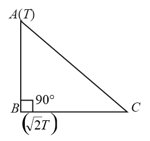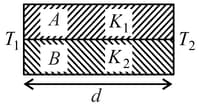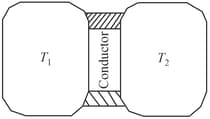A copper rod long has a circular cross-section of radius One end is kept at and the other at and the surface is covered by non- conducting material to check the heat losses through the surface. The thermal resistance of the in degree Kelvin per watt (closest to nearest integer) is (Take thermal conductivity of copper)
Important Questions on Heat and Thermodynamics


Consider a pair of insulating blocks with thermal resistances , and as shown in the figure. The temperature at the boundary between the two blocks is

| Heat flow | Electrostatics |
A metallic prong consists of rods made of the same material, cross-section, and same lengths as shown.

The three forked ends are kept at and the handle end is at The temperature of the junction is
Statement Convection involves flow of matter within a fluid due to unequal temperatures of its parts.
Statement A hot bar placed under a running tap water loses heat due to effect of convection within water.
Statement. Heat transfer always involves temperature difference between two systems.
Three rods of identical cross-section and length are made of three different materials of thermal conductivity and , respectively. They are joined together at their ends to make a long rod (see figure). One end of the long rod is maintained at and the other at (see figure). If the joints of the rod are at and in steady and there is no loss of energy from the surface of the rod, the correct relationship between and is :

Two rods A and B of different materials are welded together as shown in figure. Their thermal conductivities are and . The thermal conductivity of the composite rod will be

Consider a ball of mass attached to one end of a spring and immersed in water. Assume the complete system is in thermal equilibrium. The spring is now stretched to and the mass is released so that it vibrates up and down. Estimate the change in temperature of water before the vibrations stop.
(Specific heat of the material of the ball and Specific heat of water )
The temperature at the junction of two insulating sheets, having thermal resistances and as well as top and bottom temperatures and (as shown in figure) is given by :

A rod of thermal resistance is joined at the middle of an identical rod as shown in figure. The ends and are maintained at and respectively. The heat current in is . The value of is

A thin piece of thermal conductor of constant thermal conductivity insulated on the lateral sides connects two reservoirs which are maintained at temperatures, and, as shown. Assuming that the system is in steady-state, which of the following plots best represents the dependence of the rate of change of entropy on the ratio of temperatures,


